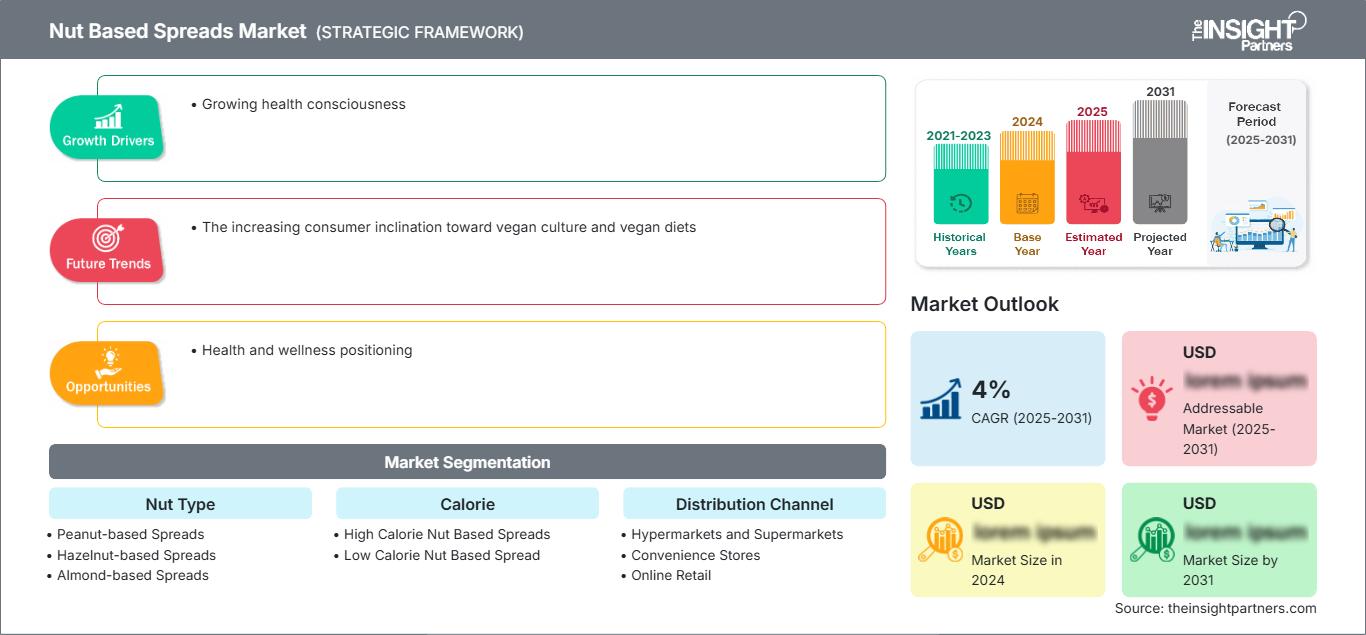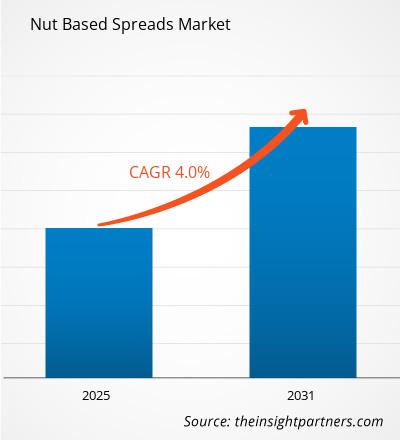Si prevede che il mercato dei prodotti a base di frutta secca registrerà un CAGR del 4% nel periodo 2023-2031. La crescente inclinazione dei consumatori verso la cultura e le diete vegane è destinata a rimanere una tendenza chiave nel mercato.
Analisi del mercato a base di frutta secca:
- Un numero crescente di consumatori che passano dalle tradizionali marmellate e creme spalmabili conservanti alle creme spalmabili a base di frutta secca per la colazione darà impulso al mercato delle creme spalmabili a base di frutta secca in tutto il mondo.
- Sebbene le creme spalmabili a base di frutta secca fossero una parte popolare delle diete occidentali tradizionali, oggi le creme spalmabili a base di frutta secca sono consumate e apprezzate anche nei paesi non occidentali.
- Il crescente consumo di creme spalmabili a base di frutta secca nei paesi dell'Asia orientale sta aumentando le vendite globali di creme spalmabili a base di frutta secca.
- Le creme spalmabili a base di arachidi e burro di arachidi sono consumate sempre più da vegani e vegetariani a causa dell'elevato contenuto di proteine vegetali.
- A causa della crescente popolarità delle creme spalmabili a base di arachidi tra la crescente base di consumatori vegetariani e vegani in Occidente, il consumo di creme spalmabili a base di frutta secca è aumentato.
- Crescente domanda da parte dei consumatori di creme spalmabili a base di frutta secca a basso contenuto di grassi Il basso contenuto calorico sta migliorando la segmentata base di consumatori. Con l'introduzione di creme spalmabili a base di frutta secca a basso contenuto di grassi, si prevede un'impennata del mercato delle creme spalmabili a base di frutta secca.
Panoramica del mercato delle creme spalmabili a base di frutta secca
- Le creme spalmabili a base di frutta secca sono creme spalmabili per la colazione, ottenute macinando frutta secca e frutta secca secca, come anacardi, arachidi, mandorle, nocciole, ecc., fino a ottenere una pasta.
- Le creme spalmabili a base di frutta secca sono ricche di proteine, acidi grassi essenziali e carboidrati. Pertanto, sono un alimento ideale per la colazione. Si spalmano sul pane e sui toast.
- Le creme spalmabili a base di frutta secca, come le creme spalmabili al burro di arachidi, sono ricche di aminoacidi, vitali per la crescita dei bambini.
Personalizza questo rapporto in base alle tue esigenze
Potrai personalizzare gratuitamente qualsiasi rapporto, comprese parti di questo rapporto, o analisi a livello di paese, pacchetto dati Excel, oltre a usufruire di grandi offerte e sconti per start-up e università
Mercato delle creme spalmabili a base di noci: Approfondimenti strategici

- Ottieni le principali tendenze chiave del mercato di questo rapporto.Questo campione GRATUITO includerà l'analisi dei dati, che vanno dalle tendenze di mercato alle stime e alle previsioni.
Driver e opportunità del mercato a base di frutta secca: crescente consapevolezza della salute
Potrai personalizzare gratuitamente qualsiasi rapporto, comprese parti di questo rapporto, o analisi a livello di paese, pacchetto dati Excel, oltre a usufruire di grandi offerte e sconti per start-up e università
Mercato delle creme spalmabili a base di noci: Approfondimenti strategici

- Ottieni le principali tendenze chiave del mercato di questo rapporto.Questo campione GRATUITO includerà l'analisi dei dati, che vanno dalle tendenze di mercato alle stime e alle previsioni.
- La crescente consapevolezza della salute tra i consumatori stimola la crescita del mercato delle creme spalmabili a base di frutta secca.
- Le creme spalmabili a base di frutta secca, come il burro di mandorle, il burro di anacardi e le creme spalmabili a base di frutta secca mista, vantano una bontà naturale e ricca di nutrienti, ricche di proteine, grassi sani e vitamine e minerali essenziali.
- Dato che i consumatori cercano sempre più alternative nutrienti alle creme spalmabili che spesso contengono zuccheri aggiunti e ingredienti artificiali, le creme spalmabili a base di frutta secca stanno diventando popolari man mano che i consumatori adottano diete a base vegetale, paleo e chetogeniche.
- I produttori stanno rispondendo a questa crescente domanda con maggiore innovazione e varietà, sviluppando creme spalmabili per i consumatori attenti alla salute che cercano creme spalmabili gustose, multifunzionali e nutrienti.
Posizionamento in ambito salute e benessere
- Si prevede che il mercato delle creme spalmabili a base di frutta secca trarrà vantaggio dalla crescente tendenza alla salute e al benessere tra i consumatori, poiché un numero crescente di persone sta adottando Le alternative vegetali alle creme spalmabili tradizionali e le creme spalmabili a base di frutta secca sono viste come una proposta di valore ricca di valore nutrizionale.
- Queste creme spalmabili sono naturalmente ricche di proteine, grassi sani e fibre, in linea con le principali preferenze alimentari dei consumatori attenti alla salute e al benessere.
- Gli operatori del marketing possono sfruttare la capacità delle creme spalmabili a base di frutta secca di supportare il sistema cardiovascolare, fornire energia sostenibile e contribuire a una dieta nutriente, presentando al contempo gli ingredienti delle creme spalmabili come etichette pulite, senza additivi o conservanti artificiali, poiché i consumatori si orientano sempre più verso alimenti sani e minimamente lavorati.
- Inoltre, l'elevata versatilità delle creme spalmabili a base di frutta secca in un'ampia varietà di ricette e occasioni di pasto offrirebbe l'opportunità agli sforzi di marketing di evidenziare le creme spalmabili come parte di una dieta e di uno stile di vita equilibrati, sani e salutari.
Analisi della segmentazione del rapporto sul mercato a base di frutta secca
L'ambito del mercato globale a base di frutta secca è segmentato in base al tipo di frutta secca, alle calorie e alla distribuzione canale.
- In base al tipo di frutta secca, il mercato dei prodotti a base di frutta secca è segmentato in creme spalmabili a base di arachidi, creme spalmabili a base di nocciole, creme spalmabili a base di mandorle, creme spalmabili a base di noci, creme spalmabili a base di anacardi e altri tipi di frutta secca.
- In base alle calorie, il mercato è suddiviso in creme spalmabili a base di frutta secca ad alto contenuto calorico e creme spalmabili a base di frutta secca a basso contenuto calorico.
- In base al canale di distribuzione, il mercato è suddiviso in ipermercati e supermercati, minimarket, vendita al dettaglio online e altro.
Analisi della quota di mercato dei prodotti a base di frutta secca per area geografica
- Il rapporto sul mercato dei prodotti a base di frutta secca comprende un'analisi dettagliata di cinque principali regioni geografiche, che include le dimensioni attuali e storiche del mercato e le previsioni per il periodo 2021-2031, coprendo Nord America, Europa, Asia-Pacifico (APAC), Medio Oriente e Africa (MEA) e Sud e Centro America.
- Ogni regione è ulteriormente suddivisa nei rispettivi paesi. Questo rapporto fornisce analisi e previsioni di oltre 18 paesi, coprendo le dinamiche del mercato a base di frutta secca, come fattori trainanti, tendenze e opportunità che influenzano i mercati a livello regionale.
- Inoltre, il rapporto comprende l'analisi delle cinque forze di Porter, che prevede lo studio dei principali fattori che influenzano il mercato a base di frutta secca in queste regioni.
Mercato delle creme spalmabili a base di noci
Le tendenze regionali e i fattori che influenzano il mercato delle creme spalmabili a base di frutta secca durante il periodo di previsione sono stati ampiamente spiegati dagli analisti di The Insight Partners. Questa sezione illustra anche i segmenti e la geografia del mercato delle creme spalmabili a base di frutta secca in Nord America, Europa, Asia-Pacifico, Medio Oriente e Africa, America meridionale e centrale.
Ambito del rapporto di mercato sulle creme spalmabili a base di noci
| Attributo del rapporto | Dettagli |
|---|---|
| Dimensioni del mercato in 2024 | US$ XX million |
| Dimensioni del mercato per 2031 | US$ XX Million |
| CAGR globale (2025 - 2031) | 4% |
| Dati storici | 2021-2023 |
| Periodo di previsione | 2025-2031 |
| Segmenti coperti |
By Tipo di frutta secca
|
| Regioni e paesi coperti | Nord America
|
| Leader di mercato e profili aziendali chiave |
|
Densità degli operatori del mercato delle creme spalmabili a base di noci: comprendere il suo impatto sulle dinamiche aziendali
Il mercato delle creme spalmabili a base di frutta secca è in rapida crescita, trainato dalla crescente domanda da parte dei consumatori finali, dovuta a fattori quali l'evoluzione delle preferenze dei consumatori, i progressi tecnologici e una maggiore consapevolezza dei benefici del prodotto. Con l'aumento della domanda, le aziende stanno ampliando la propria offerta, innovando per soddisfare le esigenze dei consumatori e sfruttando le tendenze emergenti, alimentando ulteriormente la crescita del mercato.

- Ottieni il Mercato delle creme spalmabili a base di noci Panoramica dei principali attori chiave
Il mercato dei prodotti a base di frutta secca viene valutato raccogliendo dati qualitativi e quantitativi dopo ricerche primarie e secondarie, che includono importanti pubblicazioni aziendali, dati di associazioni e database. Di seguito è riportato un elenco degli sviluppi del mercato in termini di innovazioni, espansione aziendale e strategie:
- CRAVE Healthy Food, con sede nel Regno Unito, ha introdotto un'alternativa al burro di arachidi senza frutta secca, a base di semi di girasole, per chi soffre di allergia alle arachidi. Questa crema spalmabile è accessibile a circa il 2% dei bambini del Regno Unito, con solo 1 su 5 che supera la propria allergia, secondo Allergy UK. (Fonte: CRAVE Healthy Food, Newsletter, marzo 2024)
- Voyage Foods ha annunciato un nuovo accordo di distribuzione al dettaglio con Walmart. L'azienda lancerà le sue creme spalmabili senza arachidi e senza nocciole in oltre 1200 negozi Walmart e su Walmart.com questo ottobre, segnando la sua più grande espansione dalla sua nascita due anni fa. (Fonte: Voyage Foods, Newsletter, ottobre 2023)
Copertura e risultati del rapporto di mercato sul mercato a base di frutta a guscio
Dimensioni e previsioni del mercato del mercato a base di frutta a guscio (2021 - 2031) fornisce un'analisi dettagliata del mercato che copre le seguenti aree:
- Dimensioni e previsioni del mercato a base di frutta secca a guscio a livello globale, regionale e nazionale per tutti i segmenti di mercato chiave coperti dall'ambito
- Tendenze del mercato a base di frutta secca e dinamiche di mercato come fattori trainanti, vincoli e opportunità chiave
- Analisi dettagliata delle cinque forze PEST/Porter e SWOT
- Analisi del mercato a base di frutta secca che copre le principali tendenze del mercato, il quadro globale e regionale, i principali attori, le normative e i recenti sviluppi del mercato
- Analisi del panorama industriale e della concorrenza che copre la concentrazione del mercato, l'analisi della mappa di calore, i principali attori e i recenti sviluppi per il mercato a base di frutta secca
- Profili aziendali dettagliati
- Analisi storica (2 anni), anno base, previsione (7 anni) con CAGR
- Analisi PEST e SWOT
- Valore/volume delle dimensioni del mercato - Globale, Regionale, Nazionale
- Industria e panorama competitivo
- Set di dati Excel
Report recenti
Rapporti correlati
Testimonianze
Motivo dell'acquisto
- Processo decisionale informato
- Comprensione delle dinamiche di mercato
- Analisi competitiva
- Analisi dei clienti
- Previsioni di mercato
- Mitigazione del rischio
- Pianificazione strategica
- Giustificazione degli investimenti
- Identificazione dei mercati emergenti
- Miglioramento delle strategie di marketing
- Aumento dell'efficienza operativa
- Allineamento alle tendenze normative




















 Ottieni un campione gratuito per - Mercato delle creme spalmabili a base di noci
Ottieni un campione gratuito per - Mercato delle creme spalmabili a base di noci